
Mein Leben (German for "My Life") is the autobiography of the composer Richard Wagner, covering the years from his birth in 1813 to 1864.

Mein Leben (German for "My Life") is the autobiography of the composer Richard Wagner, covering the years from his birth in 1813 to 1864.
On 17 July 1865 in Munich, Wagner began dictating Mein Leben to his then mistress Cosima von Bülow, whom he married in 1870. King Ludwig II of Bavaria asked him to write the memoir in a letter dated 28 May 1865:
You would cause me inexpressible happiness if you were to give me an account of your intellectual and spiritual development and of the external events of your life as well. [1]
Wagner was indebted to the king, who had rescued him from a life of exile and financial embarrassment in the previous year. At around the same time in 1864, Wagner had heard the news of the death of his professional nemesis, the composer Giacomo Meyerbeer. The book therefore ends on a 'triumphant' note with the exaltation of Wagner at the death of his supposed 'enemy.' [2]
The book is amongst the most readable of Wagner's prose writings, generally free of the complex syntax that is typical of his theoretical works. His frequently tempestuous career, friendships and controversies make for a racy and often surprisingly frank account. However,
[t]he subjective quality [...] emerges most clearly [...] in the casual and sometimes condescending tone [Wagner] adopts towards contemporaries [...], and it is present in the attacks on other composers of the age, above all on Meyerbeer. [3]
Nonetheless, the book is a major source for both Wagner's life and for the world of music and culture in which he began his career.
The final section of the book, covering 1861 to 1864, was not completed until 1880. However, Wagner and Cosima had already determined to print a few copies for private circulation. The first volume was printed in 1870 in an edition of fifteen. Volumes 2 and 3 were printed in 1872 and 1875, in editions of eighteen copies. Wagner recruited the young Friedrich Nietzsche to act as proof-reader and to see the book through a press in Basel. Volume 4 was printed in 1880 in Bayreuth.
There was no intention to distribute the book beyond a small circle of trusted friends; for this reason, rumours began to grow regarding the contents. Cosima herself was worried about some of the revelations in Mein Leben – in a letter to the King she wrote:
Had I not constantly begged him to say everything, however painful it might be, there is quite a lot he would not have set down. I was bold enough to assert that you too would have asked him to do it, and so he plunges deep into a sea of unedifying memories. [4]
This is despite the fact that Wagner, in dictating to Cosima, had watered down some of his past, particularly his love life and his involvement in the 1849 Revolution in Dresden. [5] An extra copy of volumes 1 to 3 struck off by the Basel printer was acquired by the American collector Mrs. Burrell in 1892, and she was so surprised by what she read that she suspected it of being a forgery. [6]
Following a suggestion by Nietzsche, Wagner included a symbolic coat of arms as a frontispiece to the first volume. This showed a vulture (German : Geier) holding a shield with the constellation of The Plough (Wagen); thus referring both to Wagner's natural father Carl and to his beloved stepfather, Ludwig Geyer. [7] This was later the source for Nietzsche's taunt (in a footnote in his 1888 book The Case of Wagner: A Musician's Problem ), [8] that Wagner might have been Jewish, as 'a Geyer (vulture) is almost an Adler (eagle)'. Both 'Geyer' and 'Adler' were common Jewish surnames, although Ludwig Geyer was not in fact Jewish. However, as Nietzsche was at the time one of the very few who had read Mein Leben and had been a close associate of the composer, many assumed (as Nietzsche doubtless intended) that Wagner had revealed a Jewish paternity in the autobiography, which was not the case.
Over the years, and particularly after Wagner's death, Cosima attempted to recall all the copies that had been distributed. Many of these were apparently burnt by Cosima. [9] The first generally published edition did not appear until 1911, possibly to quell the rumours which had grown about the contents; [10] this was cut and adapted by the Wagner family to cover up indiscreet comments or actions by Wagner which appeared discreditable. The first complete public edition appeared in 1963 (in German). The edition translated by Andrew Gray [11] is based on this and is the first complete English translation.

Wilhelm Richard Wagner was a German composer, theatre director, polemicist, and conductor who is chiefly known for his operas. Unlike most opera composers, Wagner wrote both the libretto and the music for each of his stage works. Initially establishing his reputation as a composer of works in the romantic vein of Carl Maria von Weber and Giacomo Meyerbeer, Wagner revolutionised opera through his concept of the Gesamtkunstwerk, by which he sought to synthesise the poetic, visual, musical and dramatic arts, with music subsidiary to drama. He described this vision in a series of essays published between 1849 and 1852. Wagner realised these ideas most fully in the first half of the four-opera cycle Der Ring des Nibelungen.
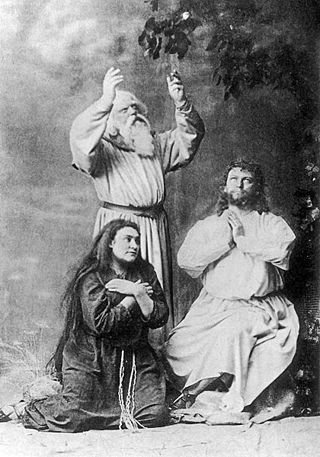
Parsifal is a music drama in three acts by the German composer Richard Wagner and his last composition. Wagner's own libretto for the work is freely based on the 13th-century Middle High German chivalric romance Parzival of the Minnesänger Wolfram von Eschenbach and the Old French chivalric romance Perceval ou le Conte du Graal by the 12th-century trouvère Chrétien de Troyes, recounting different accounts of the story of the Arthurian knight Parzival (Percival) and his spiritual quest for the Holy Grail.

Tristan und Isolde, WWV 90, is an opera in three acts by Richard Wagner to a German libretto by the composer, loosely based on the 12th-century romance Tristan and Iseult by Gottfried von Strassburg. It was composed between 1857 and 1859 and premiered at the Königliches Hoftheater und Nationaltheater in Munich on 10 June 1865 with Hans von Bülow conducting. Wagner referred to the work not as an opera, but called it "eine Handlung".
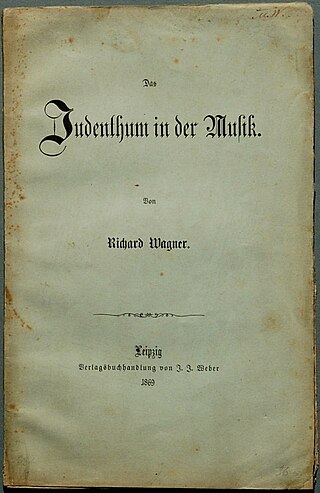
"Das Judenthum in der Musik", is an antisemitic essay by composer Richard Wagner which criticizes the influence of Jews and their "essence" on European art music, arguing that they have not contributed to its development but have rather commodified and degraded it.

Giacomo Meyerbeer was a German opera composer, "the most frequently performed opera composer during the nineteenth century, linking Mozart and Wagner". With his 1831 opera Robert le diable and its successors, he gave the genre of grand opera 'decisive character'. Meyerbeer's grand opera style was achieved by his merging of German orchestra style with Italian vocal tradition. These were employed in the context of sensational and melodramatic libretti created by Eugène Scribe and were enhanced by the up-to-date theatre technology of the Paris Opéra. They set a standard that helped to maintain Paris as the opera capital of the nineteenth century.
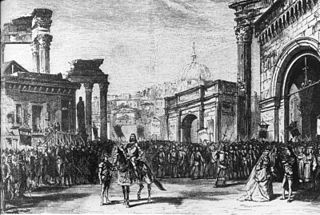
Rienzi, der letzte der Tribunen is an 1842 opera by Richard Wagner in five acts, with the libretto written by the composer after Edward Bulwer-Lytton's novel of the same name (1835). The title is commonly shortened to Rienzi. Written between July 1838 and November 1840, it was first performed at the Königliches Hoftheater Dresden, on 20 October 1842, and was the composer's first success.

Francesca Gaetana Cosima Wagner was the daughter of the Hungarian composer and pianist Franz Liszt and Franco-German romantic author Marie d'Agoult. She became the second wife of the German composer Richard Wagner, and with him founded the Bayreuth Festival as a showcase for his stage works; after his death she devoted the rest of her life to the promotion of his music and philosophy. Commentators have recognised Cosima as the principal inspiration for Wagner's later works, particularly Parsifal.
Tannhäuser is an 1845 opera in three acts, with music and text by Richard Wagner. It is based on two German legends: Tannhäuser, the mythologized medieval German Minnesänger and poet, and the tale of the Wartburg Song Contest. The story centres on the struggle between sacred and profane love, as well as redemption through love, a theme running through most of Wagner's work.

The evolution of Richard Wagner's epic operatic tetralogy Der Ring des Nibelungen was a long and tortuous process, and the precise sequence of events which led the composer to embark upon such a vast undertaking is still unclear. The composition of the text took place between 1848 and 1853, when all four libretti were privately printed. The closing scene of the final opera, Götterdämmerung, was revised a number of times between 1856 and 1872. The names of the last two Ring operas, Siegfried and Götterdämmerung, were probably not definitively settled until 1856.

The German composer Richard Wagner was a controversial figure during his lifetime, and has continued to be so after his death. Even today he is associated in the minds of many with Nazism and his operas are often thought to extol the virtues of German nationalism. The writer and Wagner scholar Bryan Magee has written:
I sometimes think there are two Wagners in our culture, almost unrecognizably different from one another: the Wagner possessed by those who know his work, and the Wagner imagined by those who know him only by name and reputation.
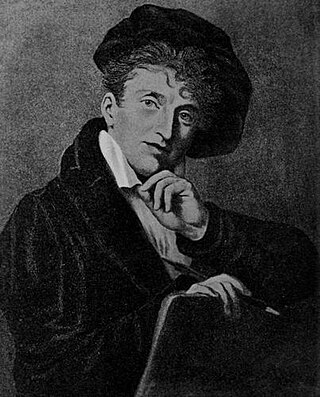
Ludwig Heinrich Christian Geyer was a German actor, playwright, and painter.

Opera and Drama is a book-length essay written by Richard Wagner in 1851 setting out his ideas on the ideal characteristics of opera as an art form. It belongs with other essays of the period in which Wagner attempted to explain and reconcile his political and artistic ideas, at a time when he was working on the libretti, and later the music, of his Ring cycle.
The Symphony in C major, WWV 29, from 1832 is the only completed symphony of Richard Wagner.

"The Artwork of the Future" is a long essay written by Richard Wagner, first published in 1849 in Leipzig, in which he sets out some of his ideals on the topics of art in general and music drama in particular.
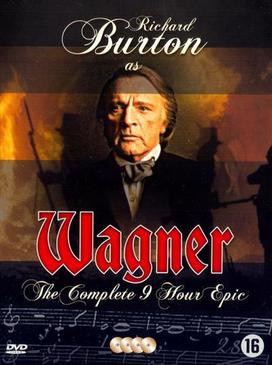
Wagner is a 1983 television miniseries on the life of Richard Wagner with Richard Burton in the title role. It was directed by Tony Palmer and written by Charles Wood. The film was later released on DVD as a ten-part miniseries.
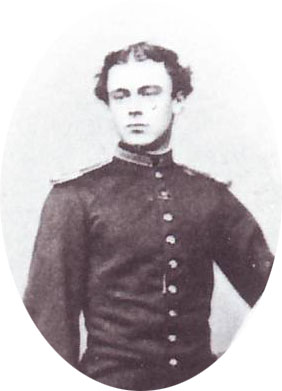
Paul Maximilian Lamoral, Prince of Thurn and Taxis, was the third child of Maximilian Karl, 6th Prince of Thurn and Taxis and his second wife Princess Mathilde Sophie of Oettingen-Oettingen and Oettingen-Spielberg. He was buried in Cannes, at the Cimetière du Grand Jas, Allée du Silence no. 33 under the name of Paul de Fels.

Theodor Uhlig was a German violin-player, composer and music critic. He was the illegitimate son of Frederick Augustus II of Saxony.

Eugénia Malvina Garrigues, was a Danish-born Portuguese operatic dramatic soprano.

Oliver Hilmes is a German author who has written several historical biographies. His study of Cosima Wagner, the daughter of the 19th century composer Franz Liszt, and his biography of Alma Mahler, the Viennese-born composer, author, editor, and socialite, have been translated into English. His book about the 1936 Olympic Games in Berlin was translated into numerous languages and received literary awards.